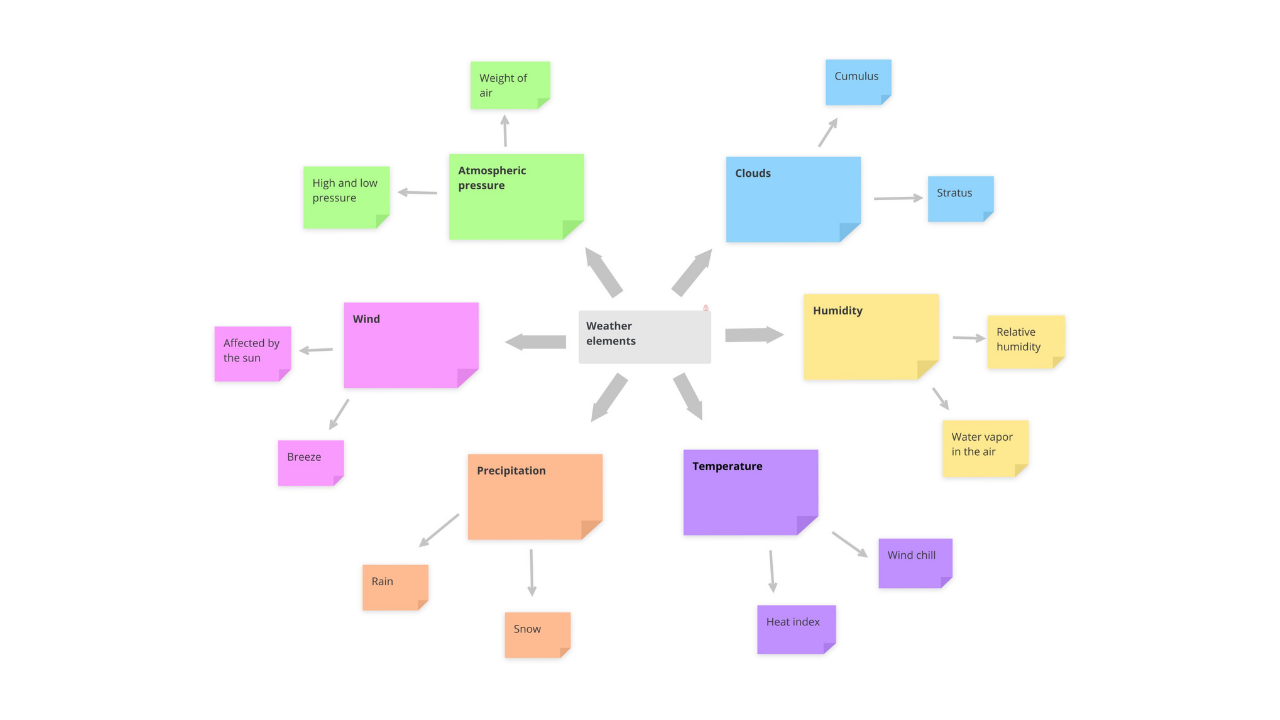Concept Map template

Ayoa’s Concept Map template provides you with the perfect canvas to organize ideas, concepts and processes, then map out the relationships between them.
What is a concept map?
A concept map is a visual tool that allows you to break down concepts, themes and processes and organize them into a hierarchical structure. Using interconnecting arrows, a concept map will enable you to easily visualize how different words and phrases relate to each other, as well as map out the order in which data and processes flow (for example, when outlining the stages of a project where many actions depend on another being completed).
Concept maps were created back in the 1970s by professor and science researcher, Joseph D. Novak, and were originally intended to be used to enhance learning. However, although concept maps are great for simplifying concepts so you can teach yourself and others, they can be used by anyone who needs to structure information, or even as a creative brainstorming tool.
What is the difference between a mind map and a concept map?
At first glance, a concept map looks similar to a mind map (another popular creative thinking and organization tool), and they are often used interchangeably. However, although both types of maps can be used to generate ideas, memorize concepts and structure work and processes, the key difference between them is that mind maps have one main focus (outlined in the center of the map), with branches radiating out from this in a linear format. Concept maps, on the other hand, are typically used to map out larger amounts of information and have cross-connections between branches to signify their complex relationships.
Why should you use a concept map?
By mapping out themes, concepts and processes and the relationships between them, concept maps are extremely useful tools for putting information into a clear, visual structure that’s easy to understand. For this reason, they can be used by teams and individuals in various industries, including education, marketing, design, development, and project management. Ayoa’s concept map maker is extremely simple to use, so anyone can get started quickly!
Concept maps were originally intended to be a learning tool, and teachers can greatly benefit from using them to structure information in a way that can be easily explained to students either in lessons or by providing them with helpful resources they can use on their own (such as visual revision aids). For engineers and development teams, they can be used to map out workflows, while marketing and other creative teams may use them to do the same with projects and user flows (such as the actions taken by visitors of their website), or even to visualize data. In fact, marketing, public relations, design, and other creative teams can use concept maps to generate ideas as a group, then put them into a structured plan!
How to use our Concept Map template
Looking for a simple to use concept map maker to help you get started? Our premade template is already populated with all the elements you need, so you can quickly start mapping out ideas, concepts and processes. Discover how to use our template below.
To access the template, sign up to Ayoa. Once you've signed up, navigate to the homepage to create a new whiteboard, mind map or task board and choose this template from the library.
Start by defining the topic you want to explore in your concept map. As we’ve already explained, this could be a large project, workflow, concept or even a specific piece of work (such as an essay or presentation). Use the box in the center of the template to explain what this is in as few words as possible.
Now it’s time to start mapping your topic! Use the existing shapes (or delete them and add new ones) to add ideas (or ‘branches’) to your concept map. Use arrows to make clear connections between ideas or to show the order in which a process should flow. Remember, this doesn’t just have to be in a linear order and some branches can link back to an earlier step in the process if needed. In the case of a user’s journey when visiting your website, they might add items to their cart, then check out. However, others will abandon their cart and navigate to other pages before going back to check out. Make sure your arrows reflect both eventualities.
If needed, add different shapes, images, attachments and colors to the template to act as visual cues. This is extremely helpful if you’re using your map as a memorization tool as images help us to make associations between ideas, which can lead to better recall.
Ready to share your concept map with others? Invite them to your board, giving them either view only or editing access. If you want to collaborate with other users and let them contribute to it alongside you, simply share your map with them before adding your own ideas.
